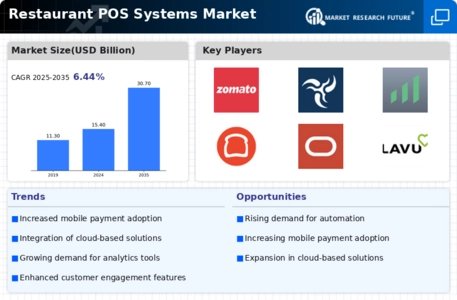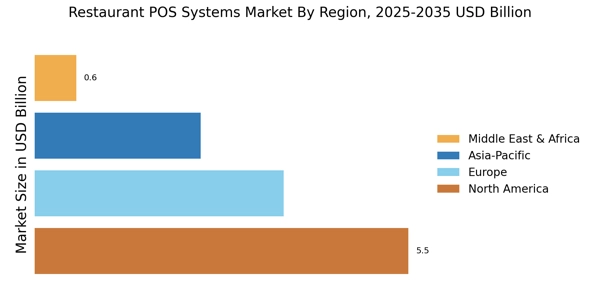Integration of Advanced Analytics
The integration of advanced analytics into Restaurant POS Systems Market is becoming increasingly prevalent. Restaurants are leveraging data analytics to gain insights into customer preferences, sales trends, and operational efficiencies. By utilizing sophisticated analytics tools, establishments can make informed decisions that enhance profitability and customer engagement. Recent studies indicate that restaurants employing data-driven strategies have seen a 15 to 20% increase in revenue. This trend underscores the importance of POS systems that not only process transactions but also provide actionable insights. As the market evolves, the ability to harness data effectively will likely distinguish successful restaurants from their competitors, making advanced analytics a critical driver in the Restaurant POS Systems Market.
Growing Emphasis on Customer Experience
In the Restaurant POS Systems Market, there is a growing emphasis on enhancing customer experience. Modern consumers expect seamless interactions, from ordering to payment. POS systems that offer features such as personalized promotions, loyalty programs, and efficient order management are becoming essential. Research indicates that restaurants focusing on customer experience can achieve up to a 30% increase in repeat business. This trend highlights the necessity for POS systems to evolve beyond mere transaction processing to become integral tools for customer engagement. As restaurants strive to differentiate themselves in a crowded market, investing in POS systems that prioritize customer experience is likely to yield substantial returns.
Increased Demand for Contactless Payments
The Restaurant POS Systems Market is experiencing a notable surge in demand for contactless payment solutions. As consumers increasingly prefer the convenience and safety of contactless transactions, restaurants are compelled to adopt advanced POS systems that facilitate these payment methods. According to recent data, the adoption of contactless payments in the restaurant sector has risen significantly, with estimates suggesting that over 60% of transactions are now conducted via contactless methods. This shift not only enhances customer satisfaction but also streamlines operations, allowing for quicker service and reduced wait times. Consequently, restaurants that integrate contactless payment capabilities into their POS systems are likely to gain a competitive edge in the market, positioning themselves favorably in an evolving consumer landscape.
Rise of Mobile Ordering and Delivery Services
The rise of mobile ordering and delivery services is a significant driver in the Restaurant POS Systems Market. As consumers increasingly opt for the convenience of ordering food through mobile applications, restaurants must adapt their POS systems to accommodate these changes. Data suggests that mobile ordering can increase sales by up to 25%, as it allows for greater accessibility and convenience for customers. Consequently, POS systems that integrate seamlessly with mobile ordering platforms are becoming indispensable. This trend not only enhances operational efficiency but also meets the evolving expectations of consumers, positioning restaurants to thrive in a competitive landscape.
Regulatory Compliance and Security Enhancements
Regulatory compliance and security enhancements are critical drivers in the Restaurant POS Systems Market. As data breaches and cyber threats become more prevalent, restaurants are increasingly prioritizing the security of their payment systems. Compliance with regulations such as PCI DSS is essential for protecting customer data and maintaining trust. Recent statistics indicate that restaurants investing in secure POS systems experience a 40% reduction in security incidents. This focus on security not only safeguards customer information but also mitigates potential financial losses associated with data breaches. As the market continues to evolve, the emphasis on regulatory compliance and security will likely remain a key consideration for restaurants when selecting POS systems.

















Leave a Comment